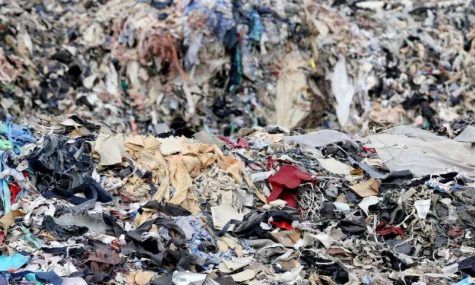The Effect of Fast Fashion on Human Rights and the Environment

Imagine walking into a mall on Black Friday. Hundreds are crowding the entrances of stores, trying to get ahold of the numerous deals and sales. Some of the most popular clothing brands in the world: H&M, Forever 21, Zara – have over 30% off discounts. While thousands try on and purchase many shirts, pants and accessories, what is not recognized is who put in the effort to produce that clothing. Majority of the pieces people had tried on were manufactured with sweatshops in countries such as China and Bangladesh, forcing workers to work for grueling hours with terrible conditions to generate an extremely low pay. Many companies use fast fashion, or cheap yet high-style clothing options that are constantly being replaced by newer, trendier alternatives. However, in order to maintain this low price tag, fast fashion comes with numerous consequences, including the significantly low quality of the items, the mistreatment and the violation of workers’ human rights, the dumping of thousands of clothing pieces into landfills, and forcing workers to work with potentially hazardous and toxic chemicals. Fast fashion is a highly unrecognized issue, although it displays clear indicators of harm throughout our modern-day world.
To begin, fast fashion began to rise to the top of the industry only decades ago. The history dates back to the 1800s, with the introduction of the sewing machine. This caused clothing to be produced significantly quicker and at a considerably reduced cost. Many of the new fashion companies accommodated workers in sweatshops, which led to numerous safety hazards. Take the Triangle Shirtwaist Factory disaster for example, where the death of over a hundred dressmakers occurred as they tried to escape a building without the proper fire safety necessities. The expansion of fast fashion gradually increased, until it achieved its height during the late 1990s to early 2000s, specifically with the use of online shopping. The name “fast fashion” was derived from the New York Times using Zara’s mission statement, describing how clothing could go from a designer’s head to on the racks within 15 days. The most critical companies involved with fast fashion include many prominent stores such as UNIQLO, TopShop, GAP, Primark, Zaful and Boohoo.
Many headlines around the world have displayed how urgently these men and women working in sweatshops need help, demonstrated by them embroidering messages or attaching notes into clothing. This is due to their devastating working conditions, some working over a hundred hours each week, yet still not generating enough pay to even support their families. Companies target their factories in countries such as India, China and Bangladesh, knowing many citizens are in desperate need of jobs. They manipulate these innocent people due to the low manufacturing cost, and force them to accomplish tremendous amounts of work in order to allow them to even have a chance of earning a living wage. Not only this, but while working, many workers don’t even have the ability to obtain any sort of breaks, some not even being able to partake in lunch at times. For example, in an article written by Green America, an H&M worker stated “we are not allowed to go to the toilet, the targets are so high. The in-charge says things like, ‘if you go to the toilet, who will do the work? Who is going to complete the target? Go to work and finish it.” Additionally, out of all of the workers in the fast fashion industry, over 85% of them are women, making gender-based harassment and exploitation extremely common. Those with disciplinary power have the ability to promote physical, verbal and sexual harm on workers, especially in male-dominated societies.
With the increased pressures of competition and producing items as quickly yet cheaply as possible, many companies do not acknowledge how their business decisions affect the environment. The whole premise of fast fashion is to design clothing that quickly goes out of style, constantly encouraging consumers to buy more poorly made clothes that are trendier with the current day and age. This results in thousands of pieces being thrown out or trashed daily, containing toxic textile dyes that not only fill landfills, but are the second largest polluter of clean water. Textiles themselves contribute to pollution as well, such as polyester, which is derived from fossil fuels, adding to global warming and leading to increased plastic levels in the ocean. Additionally, cotton demands immense amounts of water and pesticides, which can be difficult to produce specifically in developing countries with the consequences of droughts, stress on water basins, and less biodiversity. In the countries in which these factories are located, workers are forced to use potentially toxic and cancer-causing chemicals with their bare hands, proceeding to emit them into nearby bodies of water. These pesticides and chemicals in the water have caused the death of numerous farmers, and increases the number of birth defects, brain tumors, and cancer in workers as well.
While there may be many issues with fast fashion, numerous sources have proven how it is on the decline. As more people begin to acknowledge this issue and how it desperately needs to end, many companies have released more and sustainable fashion initiatives. One large movement involving fast fashion occurs during Fashion Revolution Week, in which people are encouraged to ask where their clothes come from. Additionally, those who partake in this event have declared how they don’t want their clothes to exploit people or destroy our planet. Specifically in the millennial generation, some suggest how large companies can no longer feed into mindless consumerism, since many are taking the initiative to select more environmentally friendly and sustainable options. Everyday citizens can contribute to a solution for this problem as well, the first step being to reduce the amount of clothes we buy. While inexpensive, low-quality items may be tempting, instead buy longer-lasting and eco-friendly options. An example is finding clothing through second-hand or thrifted shops, or researching and purchasing environmentally sustainable fabrics or textiles. Fast fashion is an unethical system that requires change, which can only be accomplished with the involvement of a more substantial number of people. As the issue gains more recognition, it will create a lasting effect on our environment and those stripped of their human rights while working for these large fashion companies.
Hello! My name is Eileen Lincoln, and I am a junior here at Oakton! This is my third year in journalism but my first year as an Editor-in-Chief. I mainly...







